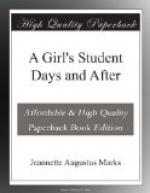Get good materials and good colours. They need not be expensive. Remember that colours have to go together just as furniture has to do so. To have styles of furniture that clash or colours that do not harmonize will negative any care which the student may have taken in the selection of individual pieces or materials. To have too much with which to fill the room is a good deal worse than not to have enough. Much better it is to have a few things which are just what they should be than to have too many and those undesirable. To get a desk, if a girl can afford to do so, that she will be glad to keep her life long is a good beginning, and a comfortable chair that will be made doubly precious by all the school associations woven about it. And let her be careful about pictures for her walls and not crowd them with cheap and “fashionable” trash. Above all, let her remember that good taste, simplicity, careful selection, will do more to assure her the possession of an attractive room than all the money in the world can do.
V
THE TOOLS OF STUDY AND THEIR USE
A girl ought to take up her study with the same sense of pleasure as that with which a strong workman enters his shop, knowing his tools and able to use them. Having good tools and knowing them is certainly part of the joy of work. And what are the tools the student must use? Well, for the average student, the one that is first and most important is Good Health. The mind is not as clear if the body is not in good health, clean within and without.
The second set of tools consists of a different sort of equipment and apparatus, tools with which a girl must become familiar and which she must know how to use—Books, Library, Laboratory and Classroom. Why shouldn’t a student be just as able to use her books as a carpenter his plane or saw? One couldn’t expect a fumbling carpenter or a clumsy seamstress to accomplish much work or good work. There are times when a girl need not claim to know anything but she must, at least, know where to find what she wants to know. This is the first lesson in the use of books; without knowledge of them or love for them, the student can’t get along at all. And beyond this somewhat mechanical use of books there is a deeper and larger lesson to learn; to know that a book is not merely a page of print where information may be sought but that it is a mirror in which one finds the world, its wisdom, its joy, its sorrow, its divine adventures. Robert Southey, the friend of the poet Coleridge, has written beautifully on the subject in a little poem called “His Books.”
Another tool in the student’s workshop is Previously Acquired Knowledge: that is, what one has in one’s mind. Some people’s minds are junk-shops. But a junk-shop is better than an empty shop. This previously acquired knowledge, if used rightly, becomes the tool of later courses, the servant of later years. Our stored-up facts—many of them—have not been an end in themselves. How could they be? For example, such things as paradigms and formulae and long lists of names and dates, are tools pure and simple; but the student in the workshop must have them or she will be like a carpenter who had much to do but on coming to his bench found no tools there and so was idle all day.




